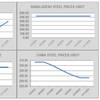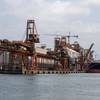Dry Bulk Fleet Utilization Falls 3.7% in Q1
Global dry bulk fleet utilization (calculated as total demand in tonne miles transported divided by total available fleet capacity) dropped by 3.7% in the first quarter of 2019, reflecting the trend observed in the rate environment, said Golden Ocean Group (GOGL), Bermuda registered, Norway based dry bulk shipping company.
According to Maritime Analytics, global fleet utilization was 82.1% in the first quarter of 2019, down from 85.8% in the fourth quarter of 2018 and 85.1% in the first quarter of 2018.
According to the same source, total seaborne transportation of dry bulk goods was 1,148 mt in the first quarter of 2019, compared to 1,142 mt in the fourth quarter of 2018 and 1,144 mt in the first quarter of 2018.
While the volume of cargo transported was unchanged from the first quarter of 2018, market disruptions resulted in shorter trade routes, less congestion and newbuilding deliveries added additional capacity in the first quarter of 2019.
Global steel production grew by 4.2% in the first quarter of 2019, driven by strong growth from China. "Chinese growth offset a 1.4% decline in steel production growth in the rest of the world. High iron ore prices following the disruption of Brazilian exports have led to draw-downs of stocks in ports and likely also at steel mills, a trend that we observed late last year," said GOGL.
Seaborne transportation of coal increased by almost 5% in the first quarter of 2019 compared to the previous quarter. Growth in transportation of agribulks was relatively unchanged in the first quarter compared to the fourth quarter of last year.
The global fleet of dry bulk vessels amounted to 837 million dwt at the end of the first quarter of 2019.
Deliveries in the first quarter of 2019 totalled 8.6 million dwt, up from 5.3 million dwt delivered during the fourth quarter of 2018 and on par with deliveries in the first quarter of 2018.
The first quarter is normally the period with highest deliveries in the year, but in 2019 the order book skews higher towards the later part of the year. The total order book is now at 92.7 million dwt, of which 41.0 million dwt is still scheduled for delivery in 2019. This includes several orders placed in 2015 or earlier totalling more than 13.0 million dwt, a similar number to the volume that has not even started construction, but due for delivery within year end.
Owners will also be more reluctant to take prompt delivery of vessels in the current market, lending may be more difficult to obtain, and vessels commissioned by Asian financing companies may not find ready buyers.
Scrapping increased considerably in the first quarter of 2019, driven by a weaker Capesize market and upcoming environmental regulations.
Twelve Capesize vessels were reported sold for scrap in the first quarter, and as of the date of this report, 22 Capesize vessels have reportedly been scrapped or sold for scrap, compared to 18 vessels taken out of the market for the full year of 2018.
"The Capesize fleet has therefore had negative fleet growth so far this year. Given the current weak market and the implementation of ballast water regulations starting in September 2019 followed by the low sulphur fuel regulations in 2020, we expect this trend of recycling to continue," said GOGL.
Following the drop in rates there has been limited activity in the sale and purchase market, in particular for Capesize vessels, where there have been no transactions reported over the last five months for modern tonnage. This clearly speaks to owners' expectations for a rebound in earnings and a lack of willingness to sell at lower prices.
For the smaller sized vessels, most of the activity has been on five to fifteen years old vessels. Newbuilding prices have remained consistent and have not adjusted down with the market rates, although the pace of orders has slowed down. Shipyards are active in other segments and therefore there is no need for the yards to adjust prices lower to encourage ordering.












